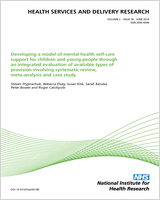NCBI Bookshelf. A service of the National Library of Medicine, National Institutes of Health.
Burton CR, Rycroft-Malone J, Williams L, et al. NHS managers’ use of nursing workforce planning and deployment technologies: a realist synthesis. Southampton (UK): NIHR Journals Library; 2018 Nov. (Health Services and Delivery Research, No. 6.36.)

NHS managers’ use of nursing workforce planning and deployment technologies: a realist synthesis.
Show detailsOperational definitions
| The worldview on staffing deployment (meta-explanations) | Organisational influences, context and responses to staffing deployment and evaluation | Influences of clinical need | Technologies and tools for articulating predictive and real-time data on patient needs |
|---|---|---|---|
Legislation, mandates, guidance:
| Organisational culture and attitude to risk management:
| Patient dependency and acuity:
| Data for risk management (red flags and staffing):
|
Patient safety and quality outcomes:
| Leadership and powerful others:
| Quality care, patient safety:
| Visibility of quality care and safety outcome data for evaluation and comparison:
|
Risk management-reduced risk of litigation:
| Organisational investment in the system and support for users:
| Patient feedback and experience:
| Standard approach to compilation of patient dependency and acuity data:
|
| Professional obligations for achievement of quality and safe patient care | Organisational feedback and evaluation:
| Impact on carers:
| |
| Corporate reputation – patient and public confidence | Organisational trial, adaptation and innovation of technologies and tools | Public perceptions:
| |
Workforce well-being – staff recruitment and retention:
| |||
| Budget restrictions – effective management of finance |
| Resource availability | Day-to-day management of resources (with/without technology) | Nurse managers’ values and use of professional judgement | Impact of managers’ day-to-day work in balancing resources and demand |
|---|---|---|---|
| Staff roles, skill mix, staff numbers | Standardised approach for establishment setting in accordance with budget | Leadership skills:
| Improved patient safety and quality outcomes |
Staff experience, capacity, capability:
| Rule-setting system (e.g. skill mix, staffing requests and adaptation for patient needs)
| Fairness; risk assessment:
| Staff satisfaction, recruitment and retention:
|
Bed state, admissions, discharges:
| Integration and visibility of complex data for comparison of patient needs and staffing requirements in the light of real time resources:
| User perceptions of technologies and tools (complexity/simplicity/trustworthiness):
| |
Bank/agency availability and costs:
| Data for evaluation: comparison of clinical areas’ actual staffing needs compared with predicted needs:
| Local knowledge; staff capabilities and environment of care:
| Cost reduction:
|
Clinical environment and geography:
| Comparison between clinical areas:
| Professional values:
| Improved organisational reputation:
|
Staff requirements (shift requests):
| Flexibility and adaptability | ||
| Experience | |||
| Confidence | |||
| Clinical understanding of patient acuity/dependency – linked to experience |
- Theory areas - NHS managers’ use of nursing workforce planning and deployment te...Theory areas - NHS managers’ use of nursing workforce planning and deployment technologies: a realist synthesis
Your browsing activity is empty.
Activity recording is turned off.
See more...